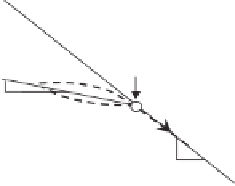Environmental Engineering Reference
In-Depth Information
n
=
1+
e
C
c
l
=
≈ 0.
434
C
c
e
ln(10)
C
s
k
=
≈ 0.
434
C
s
Yield stress
ln(10)
k
l
Preconsolidation
pressure
C
s
C
c
p
0
ln(
p
)
σ
vo
Effective vertical stress
log(
σ
v
)
Effective isotropic stress
(b) Base-10 logarithm
(a) Natural logarithm
Figure 5.17
Reference compression curves for saturated soil (from Fredlund, 2006): (a) natural
logarithm scale; (b) base-10 logarithm scale.
One-dimensional oedometer results have conventionally
been plotted as void ratio versus logarithm of vertical
stress (to the logarithm base 10). Within the elastoplastic
framework, the specific volume (1
used three-dimensional surfaces to represent the void ratio
change
de
and water content change
dw
constitutive rela-
tions for unsaturated soils. Figure 5.18 illustrates the limiting
(or bounding) relationships associated with a typical clayey
silt soil. General differential equations can be written for
small stress changes from a stress point on the void ratio
constitutive surface (Eq. 5.14) and water content constitutive
surface (Eq. 5.15):
e
) is generally plotted
versus the logarithmof mean applied stress (i.e., mean of three
principal stresses plotted using a natural logarithm base). The
mathematical relationship between the soil properties on the
two logarithm scales can be written as follows:
+
λ
=
ln
(
10
)C
c
∼
0
.
434
C
c
(5.12)
∂e
∂(σ
m
−
∂e
∂(u
a
−
de
=
u
a
)
d(σ
m
−
u
a
)
+
u
w
)
d(u
a
−
u
w
)
κ
=
ln
(
10
)C
c
∼
0
.
434
C
s
(5.13)
(5.14)
where:
∂
w
∂(σ
m
−
∂
w
∂(u
a
−
dw
=
u
a
)
d(σ
m
−
u
a
)
+
u
w
)
d(u
a
−
u
w
)
λ
=
slope of the virgin compression line on a plot of specific
volume and the natural logarithmof effective stress and
(5.15)
κ
=
slope of the rebound or reloading compression line on
a plot of specific volume and the natural logarithm of
effective stress.
where:
1
σ
m
=
mean total stress,
σ
m
=
3
(σ
1
+
σ
2
+
σ
3
),
and
σ
m
−
u
a
=
mean net stress which is referenced to pore-air
pressure,
u
a
.
The volume change versus effective stress equations for a
saturated soil can be converted to an incremental elasticity
form with respect to stress state. The elasticity modulus of
the soil changes with stress state and the solution of practical
problems becomes nonlinear. Stress reversals and complex
loading paths can also be simulated through use of more
rigorous elastoplastic models.
The constitutive relations for an unsaturated soil can be
visualized as an extension of the saturated soil model. The
extended models for an unsaturated soil include the effect of
changes in matric suction which results in further nonlinear-
ities in the soil properties. Fredlund and Morgenstern (1976)
Equations 5.14 and 5.15 have one part that designates
the stress point under consideration (i.e.,
σ
m
−
u
a
and
u
a
−
u
w
) and another part
that provides a general form
for
associated
soil
properties
[e.g.,
∂e/∂(σ
m
−
u
a
)
,
∂
w
/∂(σ
m
−
u
w
)
]. The
soil properties at a point on the constitutive surface can be
approximated as a linear compressibility modulus provided
the stress increments are relatively small. The compressibility
modulus is also a function of the stress state. There is need for
u
a
), ∂e/∂(u
a
−
u
w
)
, and
∂
w
/∂(u
a
−























Search WWH ::

Custom Search